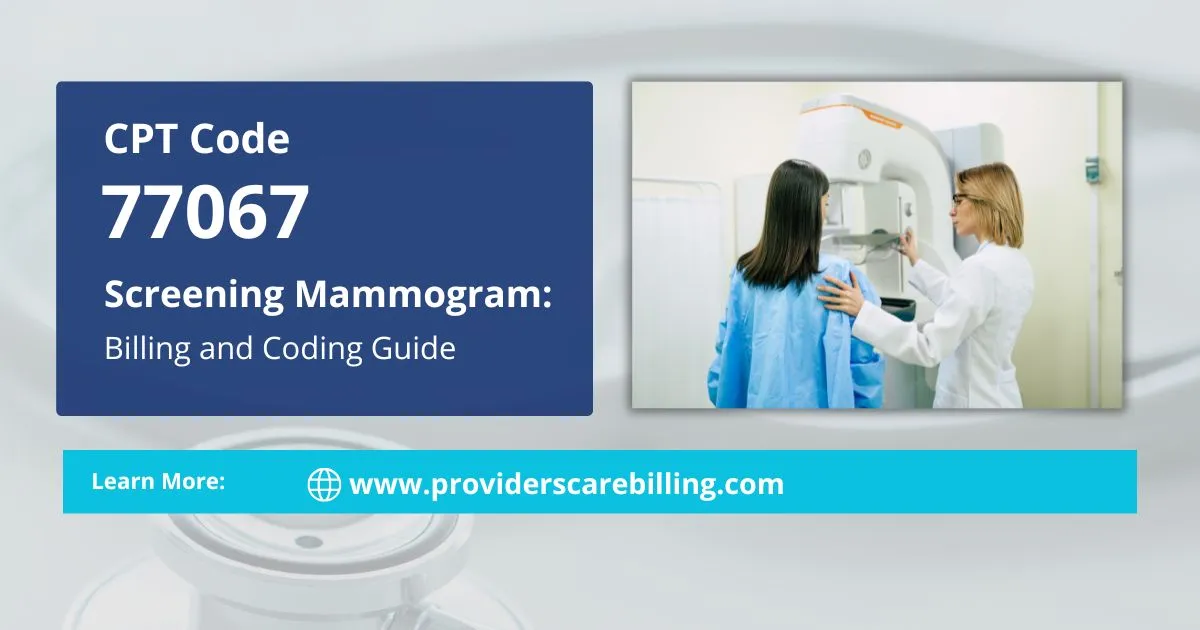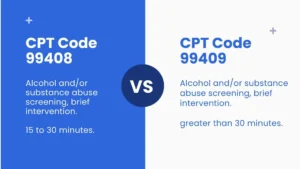It is not easy to deal with medical billing. And especially for procedures such as mammography. When billing for screening mammograms, understanding 77067 CPT code well is important. And yes, for both reimbursement and compliance with the rules. Keeping in view the importance of this code, the purpose of our blog post is to explain it deeply. It will definitely help both healthcare and billing staff, as well as patients, to understand it better.
What is CPT Code 77067?
CPT Code 77067 refers to bilateral screening mammography that includes two views of each breast and incorporates computer-aided detection (CAD) when performed. It identifies breast cancer early in women who currently do not have any signs or symptoms. The CPT code generally requires CAD technology, which shows the radiologist any suspect areas and makes detecting them easier and more precise.
Before 2018, people used the codes 77056 or 77057 to bill mammogram services, but new rules made the 77067 CPT code the preferred choice, as both codes were too confusing.
Eligibility and Clinical Indications
CPT code 77067 is perfect for:
- Women aged 40 years and above, according to the U.S. Preventive Services Task Force and American Cancer Society guidelines.
- Asymptomatic patients who lack lumps, pain, nipple discharge, or other abnormal symptoms are seen in breast cancer.
- Individuals who have an average or greater risk of breast cancer, assuming the screening is preventive and done regularly.
- Patients who have not had a screening mammogram during the last 12 months, according to the rules of their insurance company, including Medicare.
It is necessary to distinguish between screening and diagnostic mammograms. Suppose the patient already has a lump, experiences pain, or shows anything from previous testing. In that case, the proper code to use is either CPT 77065 (for unilateral lymph nodes) or 77066 (for bilateral lymph nodes).
Integration of Modifiers for Accurate Billing
When using this mammogram screening code, you should add modifiers to better describe the procedure done. Making sure modifiers are correct prevents insurance claims from being denied or rejected during review.
Common Modifiers Include
Modifier -TC (Technical Component): For the technical instruments and technicians used in the procedure.
Modifier -26 (Professional Component): For the physician’s interpretation of the images.
Modifier -52 (Reduced Services): When surgery, such as a mastectomy, changes a bilateral mammogram to a unilateral one, this modifier tells that only one breast was scanned.
Modifier -GG: Chosen when both a screening and a diagnostic mammogram are taken at the same time.
Modifier -59 (Distinct Procedural Service): Shows a procedure that can be separated and clearly defined. This clinical type is frequently coordinated with modifier GG to dodge NCCI edits.
Example
If an initial screening mammogram is discovered to have problems and a diagnostic mammogram is recommended, you should record:
- 77067 with modifier 59
- 77066 (diagnostic, bilateral) with modifier GG
Not using these modifiers could cause your claims to be rejected or for you to experience delays in getting reimbursed.
Essential Documents
You are required to present documentation to support the healthcare services you claim on your insurance or Medicare. Any preventive services given to a patient must have a clear justification in their chart.
Your documentation should include:
- Patient demographics (including age and sex)
- Date of last mammogram
- Indication for the exam (e.g., routine screening)
- Technique used (confirm bilateral views and CAD usage)
- Findings and impressions from the radiologist
- Any follow-up recommendations
In imaging centers where things are often busy, strong documentation serves to reduce the chance of audit mistakes and supports justifiable claims.
Medicare Guidelines and Reimbursement
Medicare pays for screening mammograms once every year for women over 40, with no required cost-sharing. Women over the age of 35 and 39 are eligible for one standard mammogram during this period.
Rates for reimbursing differential can be affected by the location, what kind of facility the treatment occurred, and the use of CAD.
According to the Medicare Physician Fee Schedule that is in effect for 2024,
- CPT 77067 (global): ~$135–$145 (may vary)
- Technical component: ~$90
- Professional component: ~$45
Most private insurers now provide mammograms and other preventive services without charging patients out-of-pocket, due to the Affordable Care Act.
Coding Tips and Common Mistakes
1. Do NOT submit a code of CPT 77067 for any symptomatic patients.
That’s the most common mistake. Even if the visit was scheduled for a scan, a diagnostic mammogram should be done instead (77065 or 77066).
2. Avoid double billing for CAD.
Because 77067 is local for CAD, there’s no reason to also include 77052 (which is now not used).
3. Look for routine mammogram ICD-10 codes that reflect the importance of preventive health care.
I recommend that you use code Z12.31 for a screening mammogram in a woman who is expected to be asymptomatic.
4. Check frequency limits.
The majority of payers set rules that a claim must be submitted within one year. Do not bill a screening before these 60 days, except in the case of a medical reason and the presence of supporting documents.
5. Check for age limitations.
Most insurance companies require patients to be at least 40 to obtain routine screening for free with Medicare or private insurance.
Coding Compliance and Best Practices
Healthcare offices need to develop compliance policies to ensure every bill is accurate. Here are some best practices:
- Check the patient’s benefits before the visit to ensure they are eligible for a mammogram.
- Teach coders and those at the front desk how to tell screening apart from diagnostic services.
- Regularly share information about changes to Medicare’s radiology CPT code for mammo coverage with your staff, since the guidelines can be updated from year to year.
- Organize internal audits each quarter to check for problems with billing and excessive use of modifiers such as 59 or GG.
- Add flags in the EHR to prompt coders when information is unclear in the record.
Related Reading:
If you’re also handling preventive visit codes, don’t miss our comparison of CPT Code 99395 vs 99396 — a helpful guide to billing adult wellness visits accurately.
Final Thoughts!
Using CPT code 77067 is important in preventing breast cancer. As a radiology coder, billing specialist, physician, or healthcare administrator, getting this mammography CPT code right guarantees compliance, the best streamlined reimbursement, and no disruption in preventive care for patients.
Correct coding and billing of mammograms make it possible for more women to take advantage of preventive screenings and stand a better chance of saving their lives. When you are clear about CPT code 77067 and use the best billing processes, you can make tasks smoother, avoid blunders, and ensure good health for everyone.




